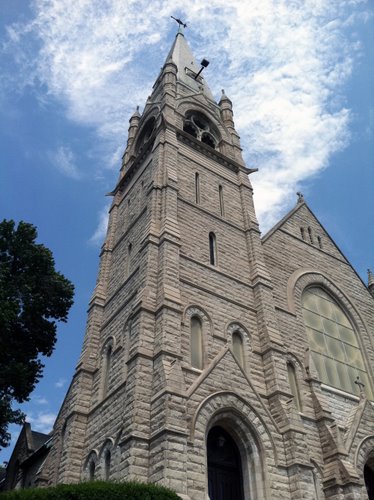 When Sacred Heart Cathedral (at the corner of Iowa and 10th streets in Davenport) was completed in 1891, its bell tower and spire was the tallest structure in the Quad Cities. Soaring majestically above the surrounding trees and neighborhood, its approximate height of 160 feet seemed even greater because of its placement at the top of a steep hill near the crest of the bluff overlooking the Mississippi.
When Sacred Heart Cathedral (at the corner of Iowa and 10th streets in Davenport) was completed in 1891, its bell tower and spire was the tallest structure in the Quad Cities. Soaring majestically above the surrounding trees and neighborhood, its approximate height of 160 feet seemed even greater because of its placement at the top of a steep hill near the crest of the bluff overlooking the Mississippi.
Several blocks to the west, Trinity Episcopal Cathedral (at 121 West 12th Street) had been constructed 18 years before. Although a spire was part of architect's original plans, it was not built because of a lack of funds.
But in 1998, Elizabeth Haines (a member of the Trinity congregation) personally financed the building of a bell tower and spire. In memory of her grandparents - who were charter members of the cathedral - the 131-foot tower was built to its original specifications.
 There are basic similarities in the towers of each cathedral. A cross is at the top of each spire and a pointed arched doorway at the base. (The door at Trinity is painted bright red, a tradition from the medieval age that signified a place of safety and refuge.) Each was primarily built with limestone. Bells are heard from each tower throughout the day and on special occasions.
There are basic similarities in the towers of each cathedral. A cross is at the top of each spire and a pointed arched doorway at the base. (The door at Trinity is painted bright red, a tradition from the medieval age that signified a place of safety and refuge.) Each was primarily built with limestone. Bells are heard from each tower throughout the day and on special occasions.
However, each has a different visual point of emphasis. The open belfry, framed with its beautiful stone tracery, is the focus of the Sacred Heart tower. The dark-copper spire, half of the tower's height, stands out on Trinity's cathedral.
And whereas Sacred Heart has a single large bell that dates back to the cathedral's construction, Trinity's tower has a carillon, a musical instrument of many bells. Both are rung electronically at present, although Sacred Heart's bell was originally rung physically with a long rope.
Despite these differences, both towers are drawn from the same medieval customs. Church bells became common in the early medieval age. Centuries later, the Gothic architectural style was developed in northern Europe. These traditions captured the imagination of architects but also of writers, artists, and composers. The novel The Hunchback of Notre Dame, the carol "I Heard the Bells on Christmas Day," the painting of Salisbury Cathedral by John Constable, and "The Bells" - a poem by Edgar Allan Poe that inspired Rachmaninoff's choral symphony of the same name - are just a few works that come to mind.
 Of course, commercial structures have superseded religious buildings in our urban landscapes. The very year that Sacred Heart was completed, the first true steel-frame skyscraper (the Wainwright Building in St. Louis) was finished. In the Quad Cities, the WHBF-TV tower in the Rock Island District stands 482 feet tall.
Of course, commercial structures have superseded religious buildings in our urban landscapes. The very year that Sacred Heart was completed, the first true steel-frame skyscraper (the Wainwright Building in St. Louis) was finished. In the Quad Cities, the WHBF-TV tower in the Rock Island District stands 482 feet tall.
But the next time you look at that steel-frame structure, visualize in its place a stone tower with a spire some 40 feet higher. This was the height of the spire of England's Lincoln Cathedral built seven centuries ago during the medieval age.
Though less breathtaking in height and longevity, the spires of Trinity and Sacred Heart cathedrals embody physical might and construction achievement, yet also spiritual longing. They, too, inspire a sense of awe.
Bruce Walters is a professor of art at Western Illinois University.
This is part of an occasional series on the history of public art in the Quad Cities. If there's a piece of public art that you'd like to learn more about, e-mail the location and a brief description to BD-Walters@wiu.edu.










